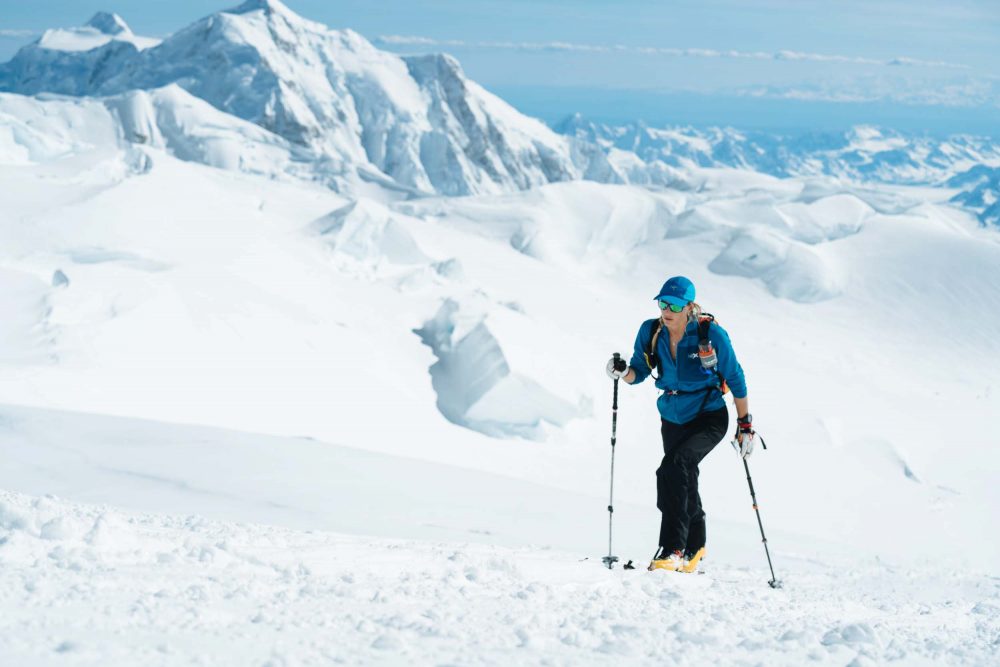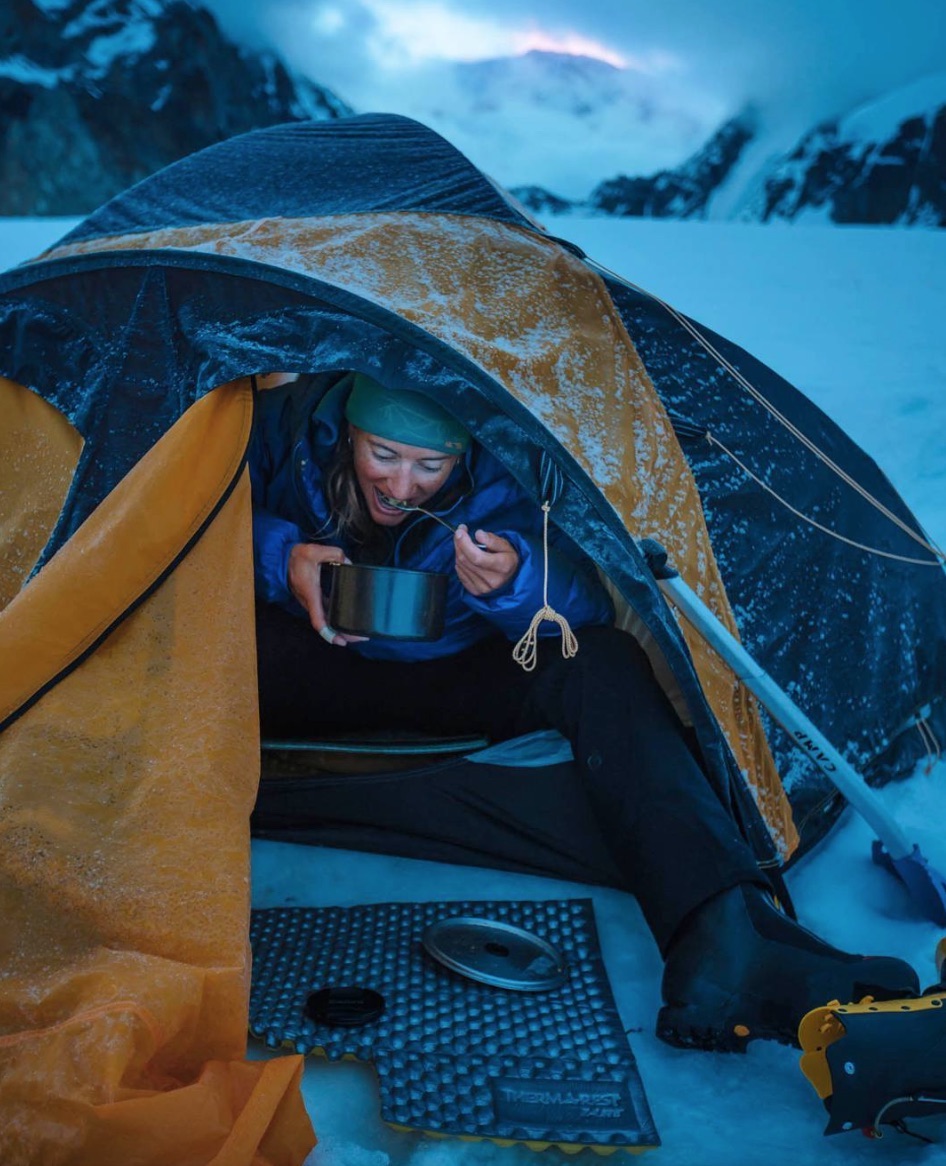
Editor’s Note: The subject of the following article, Katie Bono, spent one season as a FasterSkier reporter in 2013/2014. She also skied at Dartmouth and with the Sun Valley Ski Education Foundation, and in June, became the fastest woman to ascend and descend Denali, North America’s highest peak at 20,310 feet.
***
For close to a week, a wet nylon tent and freezing rain were Katie Bono’s world. Unzipping the door flap spared her nothing but sleet and the faint shadow of North America’s highest mountain, Denali. If it weren’t the 29-year-old Minneapolis native’s third round trip to the Alaska Range, its apex might have been indistinguishable; a distant blinking mirage emerging now and again through swirling snow.
Along with her toes, Bono’s mind had gone numb. For an alpinist climber, waiting at basecamp to summit is akin to waiting in an airport when the outgoing flight’s been delayed: When will the weather let up?
For Bono, that when came in roughly eight days. Prior to that, she had spent almost all of June acclimatizing to Denali’s elevation via the Kahiltna Glacier route. She had attempted her first summit on June 7, making it to 18,100 feet, only to be turned around due to bad weather.
Back at base camp, less than four days of food remained from her 28-day pre-planned supply. The opportunity to get what she came for — to set the fastest female roundtrip ascent record on Denali’s 20,310 foot summit — was wearing thin. When would time run out?
Luckily for her, it didn’t.
The Makings of a Mountaineer
Home of the White Mountains, New Hampshire boasts both rugged terrain and dense forest area. Nestled in its northwestern-most region, where the Appalachian Trail and Hanover’s main street become one, the state is also the home of Dartmouth College, Bono’s alma mater.
Though originally recruited for cross-country skiing (she was the 2006 Minnesota state skiing champion), within two years of attending the Ivy League university, she had learned to love what many of her Big Green comrades adored: climbing. Introduced to the sport by the Dartmouth Mountaineering Club the summer before her junior year, it took just one trip to Canning Cliff for the nordic skier to discover her new niche.
“It was just a day trip, but my first multi-pitch climb,” Bono, also a former FasterSkier reporter, said during a phone interview in July. “I forgot my headlamp and we finished in the dark. I was scared for most of the day. But after that I was pretty much hooked.”

After receiving her undergraduate degree from Dartmouth in 2010, Bono headed west to ski and train with the Sun Valley Ski Education Foundation (SVSEF) in Sun Valley, Idaho. By the turn of the year, however, Bono no longer wanted to pursue skiing professionally. Her interests were elsewhere.
“I decided I wasn’t super happy with the full-time skier lifestyle and started guiding more in Sun Valley,” Bono explained of why she stopped skiing. “Then I went out to Washington to guide a little bit more full time there.”
Bono began working as a guide for Rainier Mountaineering Inc. (RMI), but she missed the feeling of racing and soon thoughts about a speed attempt of Rainier crossed her mind. In July of 2012, she made it a reality and completed a roundtrip climb of Rainier in 4 hours and 58 minutes, setting a new female speed record (reportedly in trail-running shoes and crampons).
In terms of hours put into alpine climbing, Bono was a sport rookie, but her background in cross-country skiing gave her an edge.
“Skiing makes you pretty good at suffering and that’s a lot of what mountaineering and alpine climbing is, learning how to function and keep yourself warm, and not be terrified by just being in cold weather all the time,” said Bono, who currently lives in Boulder, Colo.
“As a skier, you are introduced to managing your layers so you don’t get super sweaty and stay warmer,” she continued. “It’s really a learning curve for people who grew up doing indoor sports or have grown up in warmer places besides Minnesota to learn how their body produces heat.”
Following her speed ascent of Rainier, while working as a guide for RMI, Bono made her first trip to Denali in 2013. Though her first time on the mountain was shrouded in rain clouds and inclement weather, she departed Denali with a speed ascent in mind. However, it wouldn’t be until four years later, after guiding a second summit in 2014 and climbing the mountain’s Cassin Ridge in 2015, that Bono would get her chance.
While finishing up prerequisites, taking the MCAT and applying to medical schools kept her from getting much training in, Bono managed to squeeze in four months of training this past winter and spring in preparation for her trip.
“I would try to do a long ski tour or two ski tours per week, like three to ten hours on the weekend,” Bono said. “During the week I would try to do several easy distance workouts a week, like one to two hours. Then fill in with one to two usually threshold interval workouts, sometimes like harder VO2-max workouts.”
By mid-May, whether her training deemed her ready or not, the mountain was calling.
The Ascent

For a total of 26 days, the Kahiltna Glacier was Bono’s home. The first two and half weeks were spent treading up and down Denali in a ladder-like style, a process she hoped would help her body become better at breathing less-oxygenated air.
“After I worked my way up to 14,000 feet … I then took a day where I’d go up to 17,000 feet and then come down and sleep at 14,000 feet. Then the next day I’d go up to 19,000 feet and then come back to 14,000 feet,” she explained.
She never saw the top of the summit during her acclimatization process. She did see temperatures dip below -30 degrees Fahrenheit and recurring snowstorms. She also witnessed an emergency evacuation after one of her team members came down with appendicitis. A few days prior to that Bono had seriously cut her hand while “trying to cut butter while cooking.”
“Classic ‘bagel slicing’ maneuver,” Bono wrote in an email about the incident. “It was a pretty deep cut! I could see some gross white stuff but quickly covered it and applied pressure.”

Undeterred, Bono returned to base camp and attempted her first speed ascent. But a snow squall that Bono assessed as too risky, forced her back down.
“I think I wanted to actually keep the risk margins on this trip relatively wide,” she said. “I think that risk tolerance varies a lot among climbers … sometimes you can also go for it in bad weather and it will work and sometimes you go for it in bad weather and you get a lot of frostbite. So I think risk tolerances can vary a lot and really make your own experience in the mountains based on that.”
Tent-ridden for eight days with a food supply soon to run out, Bono began to wonder whether she’d get what she came for. Finally, on June 13, she did. Bono climbed to the top of Denali and back down — using lightweight ski-mountaineering race skis until 14,000 feet — in time of 21 hours and 6 minutes, successfully setting the women’s speed record and third-fastest time ever on the mountain.
Long-distance runner and professional ski mountaineer, Kílian Jornet currently holds the overall roundtrip speed record at 11 hours 48 minutes. Though professional photographer, Savannah Cummins accompanied Bono to photo-document the trip, Bono completed the actual ascent and descent solo.
“Doing it solo, there’s alway a risk, but I feel like I’d spent enough time on Denali that I had a good idea of how to gauge the hazards, like crossing the crevices and the snow bridges lower down,” Bono said. “I tried to time my ascent so that I would be crossing the lower glacier, which has the most crevasces, when the snow conditions were at their most firm and most stable.”
“After a month of solid callus-building, it all felt pretty amazing,” Bono wrote on her blog following the trip.
https://www.instagram.com/p/BVqPDyiBols/?taken-by=katie__bono
Gabby Naranja
Gabby Naranja considers herself a true Mainer, having grown up in the northern most part of the state playing hockey and roofing houses with her five brothers. She graduated from Bates College where she ran cross-country, track, and nordic skied. She spent this past winter in Europe and is currently in Montana enjoying all that the U.S. northwest has to offer.



